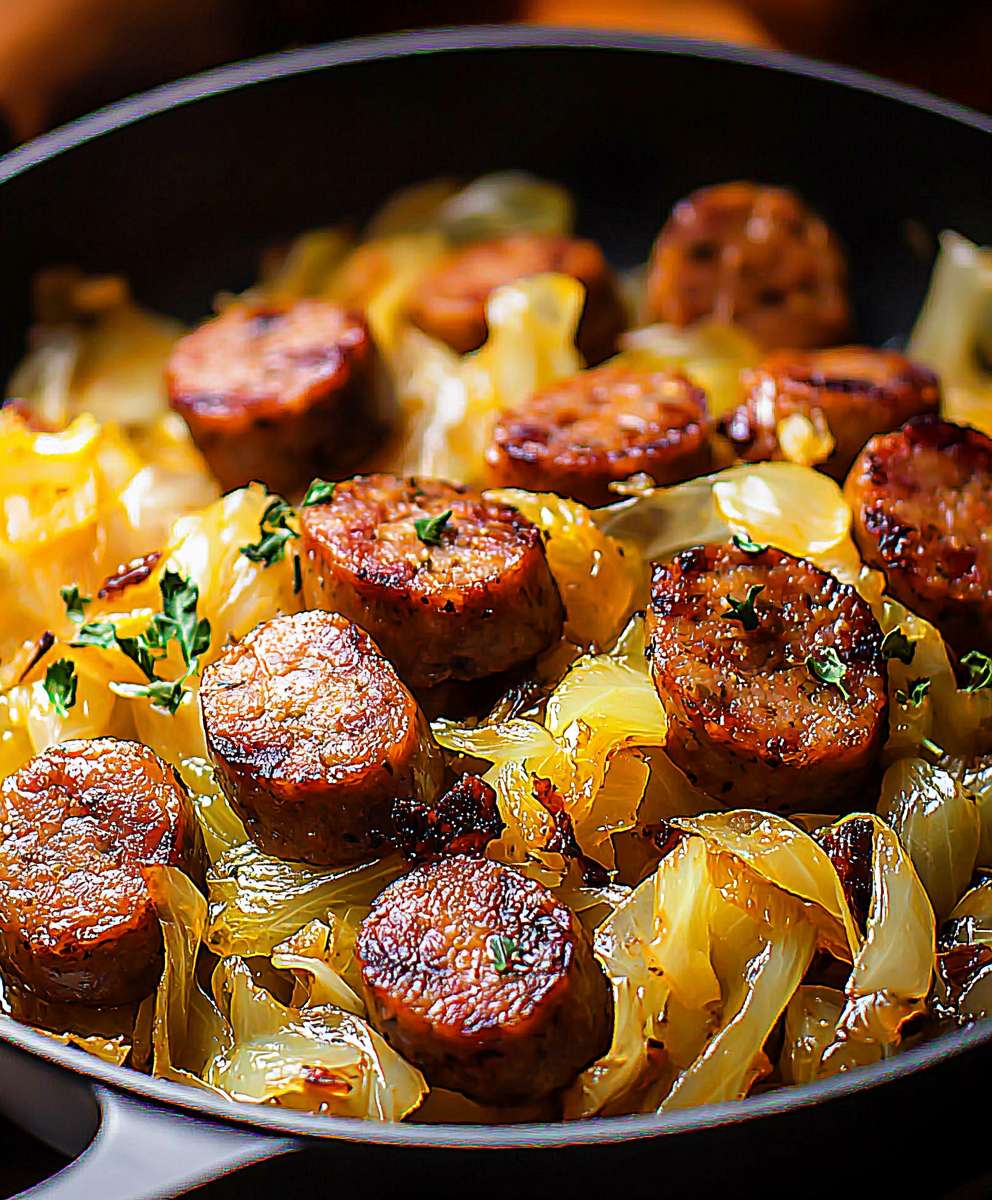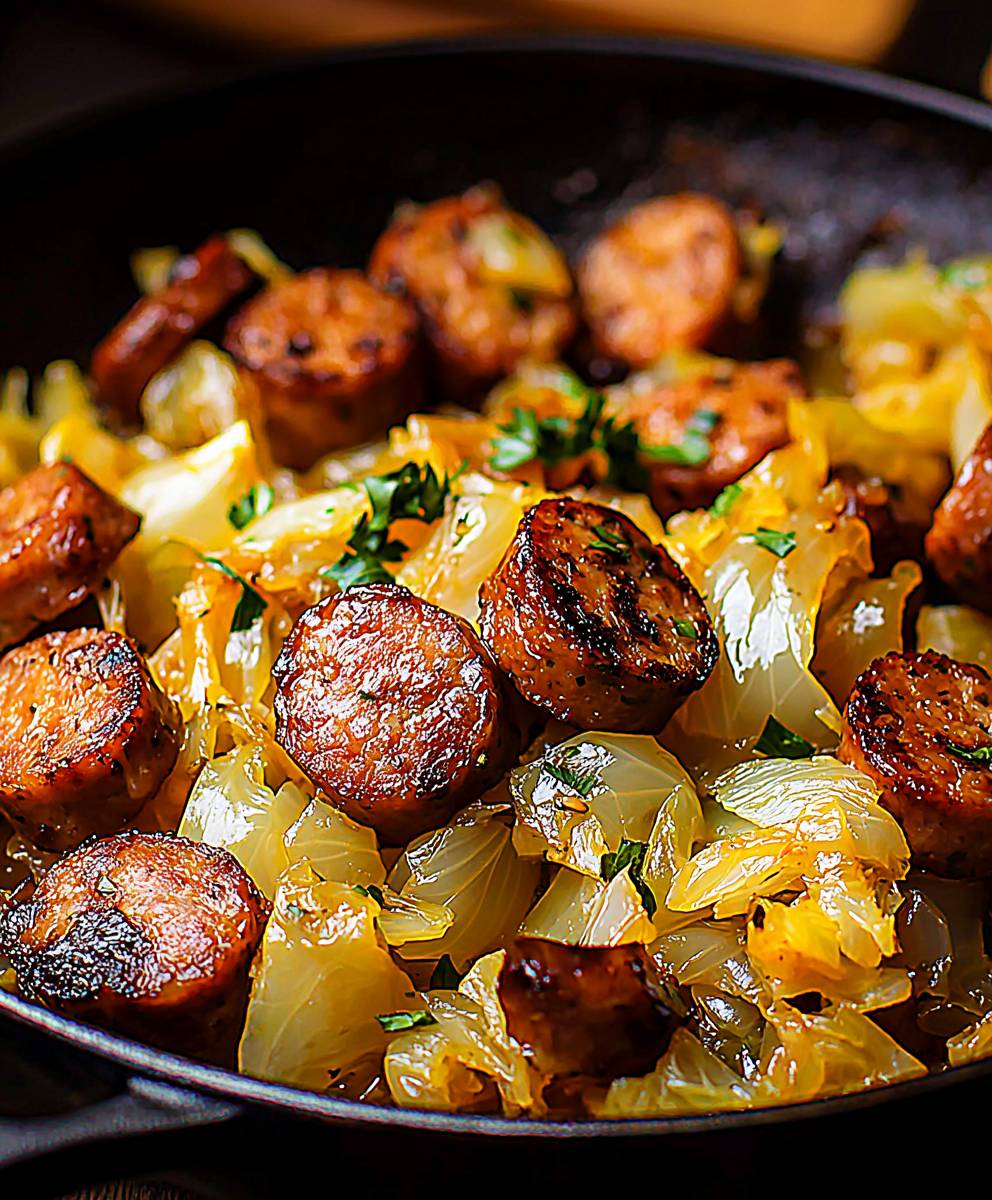Sausage cabbage skillet: it’s not just dinner; it’s a culinary hug in a pan! Imagine tender cabbage, browned sausage, and savory seasonings melding together in a symphony of flavors. This one-pan wonder is so satisfying, it’s sure to become a family favorite.
Cabbage and sausage have been paired together in various forms for centuries, particularly in Eastern European and German cuisines. Think of hearty stews and comforting braises these humble ingredients have long been staples, providing sustenance and warmth during colder months. While this particular skillet recipe might not have ancient roots, it certainly draws inspiration from those time-honored traditions of simple, flavorful cooking.
What makes this sausage cabbage skillet so irresistible? Well, for starters, it’s incredibly easy to make. We’re talking minimal prep time and only one pan to wash! But beyond the convenience, it’s the taste and texture that truly shine. The slight sweetness of the cabbage complements the savory sausage perfectly, and the slight char from the skillet adds a delightful depth of flavor. Plus, it’s a naturally gluten-free and relatively low-carb option, making it a winner for a variety of dietary needs. I think you’ll find this dish is a delicious and practical solution for busy weeknights!
Ingredients:
- 1 pound Italian sausage (sweet or hot, casings removed)
- 1 medium yellow onion, chopped
- 2 cloves garlic, minced
- 1 medium head of green cabbage, cored and shredded
- 1 red bell pepper, seeded and chopped
- 1 (14.5 ounce) can diced tomatoes, undrained
- 1/2 cup chicken broth
- 1 tablespoon olive oil
- 1 teaspoon dried oregano
- 1/2 teaspoon dried thyme
- 1/4 teaspoon red pepper flakes (optional)
- Salt and freshly ground black pepper to taste
- Optional toppings: shredded Parmesan cheese, fresh parsley, crusty bread
Preparing the Sausage and Vegetables
- Heat the olive oil in a large skillet or Dutch oven over medium-high heat. Add the Italian sausage and cook, breaking it up with a spoon, until browned and cooked through. This usually takes about 7-10 minutes. Make sure to crumble the sausage well so it cooks evenly.
- Once the sausage is cooked, remove it from the skillet with a slotted spoon and set aside. Leave any rendered fat in the skillet this will add flavor to the vegetables. If there’s excessive fat, you can drain off a little, leaving about a tablespoon or two.
- Add the chopped onion to the skillet and cook until softened and translucent, about 5-7 minutes. Stir occasionally to prevent burning. The onions should be nicely softened and starting to turn golden brown around the edges.
- Add the minced garlic to the skillet and cook for about 1 minute more, until fragrant. Be careful not to burn the garlic, as it can become bitter. Stir constantly during this step.
- Add the shredded cabbage and chopped red bell pepper to the skillet. Stir to combine with the onions and garlic. Cook, stirring occasionally, until the cabbage begins to soften and wilt, about 5-7 minutes. Don’t overcook the cabbage at this stage; you want it to retain some texture.
Simmering the Skillet
- Pour in the can of diced tomatoes (undrained) and the chicken broth. Stir to combine all the ingredients in the skillet. The liquid will help to steam the cabbage and create a flavorful sauce.
- Add the dried oregano, dried thyme, and red pepper flakes (if using). Season with salt and freshly ground black pepper to taste. Remember that the sausage may already be seasoned, so start with a smaller amount of salt and adjust as needed.
- Return the cooked sausage to the skillet. Stir to combine it with the vegetables and sauce.
- Bring the mixture to a simmer, then reduce the heat to low, cover the skillet, and cook for 15-20 minutes, or until the cabbage is tender and the flavors have melded together. Stir occasionally to prevent sticking. The longer it simmers, the more the flavors will develop.
- After 15-20 minutes, remove the lid and check the consistency of the sauce. If it’s too watery, you can continue to cook it uncovered for a few more minutes to allow some of the liquid to evaporate. If it’s too thick, you can add a splash more chicken broth.
Serving Suggestions
- Taste the sausage cabbage skillet and adjust the seasonings as needed. Add more salt, pepper, or red pepper flakes to your liking.
- Serve the skillet hot, garnished with shredded Parmesan cheese and fresh parsley, if desired. A sprinkle of fresh herbs always brightens up the dish.
- This dish is delicious on its own, but it’s also great served over rice, mashed potatoes, or polenta.
- For a heartier meal, serve with crusty bread for dipping into the flavorful sauce. The bread is perfect for soaking up all the delicious juices.
- Leftovers can be stored in an airtight container in the refrigerator for up to 3-4 days. Reheat gently on the stovetop or in the microwave.
Tips and Variations
- Spice it up: If you like a spicier dish, use hot Italian sausage and add more red pepper flakes. You could also add a pinch of cayenne pepper.
- Add other vegetables: Feel free to add other vegetables to the skillet, such as carrots, zucchini, or mushrooms. Add them along with the cabbage and bell pepper.
- Use different types of sausage: You can use other types of sausage, such as kielbasa or chorizo, in place of the Italian sausage. Just be sure to adjust the cooking time accordingly.
- Make it vegetarian: For a vegetarian version, omit the sausage and add a can of drained and rinsed cannellini beans or chickpeas. You may also want to add a teaspoon of smoked paprika to give it a smoky flavor.
- Add a touch of sweetness: A tablespoon of balsamic vinegar or a teaspoon of brown sugar can add a touch of sweetness to balance the savory flavors. Add it towards the end of the cooking time.
- Use fresh herbs: If you have fresh oregano and thyme on hand, use them instead of dried. Use about 1 tablespoon of each, chopped. Add them towards the end of the cooking time to preserve their flavor.
- Make it a one-pot meal: Add cooked pasta or rice to the skillet during the last few minutes of cooking to make it a complete one-pot meal.
- Slow cooker option: This recipe can also be made in a slow cooker. Brown the sausage and onions in a skillet, then transfer everything to the slow cooker. Cook on low for 6-8 hours or on high for 3-4 hours.
Detailed Ingredient Notes
- Italian Sausage: I prefer using sweet Italian sausage for this recipe, but hot Italian sausage works just as well if you like a little heat. Make sure to remove the casings before cooking. You can also use ground turkey or chicken sausage as a healthier alternative.
- Cabbage: Green cabbage is the most common type of cabbage used in this dish, but you can also use Savoy cabbage or red cabbage. Savoy cabbage has a slightly milder flavor and more tender leaves, while red cabbage will add a beautiful color to the dish.
- Bell Pepper: Red bell pepper adds a touch of sweetness and color to the skillet. You can also use other colors of bell pepper, such as yellow or orange. Green bell pepper has a slightly more bitter flavor.
- Diced Tomatoes: I recommend using diced tomatoes with their juice for this recipe. You can also use crushed tomatoes or tomato sauce, but the diced tomatoes will add more texture.
- Chicken Broth: Chicken broth adds moisture and flavor to the skillet. You can also use vegetable broth or beef broth.
- Olive Oil: Olive oil is used to sauté the sausage and vegetables. You can also use other types of oil, such as vegetable oil or canola oil.
- Oregano and Thyme: Dried oregano and thyme add a classic Italian flavor to the dish. You can also use other herbs, such as basil or rosemary.
- Red Pepper Flakes: Red pepper flakes add a touch of heat to the skillet. You can omit them if you don’t like spicy food.
- Salt and Pepper: Salt and pepper are used to season the dish. Be sure to taste and adjust the seasonings as needed.
- Parmesan Cheese: Shredded Parmesan cheese is a delicious topping for this skillet. You can also use other types of cheese, such as mozzarella or provolone.
- Fresh Parsley: Fresh parsley adds a touch of freshness and color to the dish. You can also use other herbs, such as basil or cilantro.
Nutritional Information (Approximate)
Note: Nutritional information is an estimate and may vary based on specific ingredients and portion sizes.
- Calories: Approximately 350-450 per serving
- Fat: 20-30g
- Saturated Fat: 8-12g
- Cholesterol: 70-90mg
- Sodium: 800-1000mg
- Carbohydrates: 20-30g
- Fiber: 5-7g
- Sugar: 8-12g
- Protein: 20-25g
This Sausage Cabbage Skillet is a versatile and flavorful dish that’s perfect for a weeknight meal. Enjoy!

Conclusion:
This sausage cabbage skillet isn’t just another weeknight dinner; it’s a flavor explosion waiting to happen! From the savory browned sausage to the tender, slightly sweet cabbage, and the hint of garlic and herbs, every bite is a comforting and satisfying experience. It’s quick, it’s easy, and it’s packed with goodness what more could you ask for?
I truly believe this recipe is a must-try for anyone looking for a simple yet delicious meal. It’s perfect for busy weeknights when you don’t have a lot of time to spend in the kitchen, but it’s also impressive enough to serve to guests. The beauty of this dish lies in its versatility. Feel free to experiment with different types of sausage Italian sausage adds a spicy kick, while chicken sausage keeps things lighter. You can also add other vegetables like bell peppers, onions, or even diced potatoes for a heartier meal.
Serving suggestions are endless! I love to serve this sausage cabbage skillet as a main course with a side of crusty bread for soaking up all those delicious juices. It’s also fantastic served over mashed potatoes or rice. For a lower-carb option, try serving it with cauliflower rice or zucchini noodles. And don’t forget the toppings! A sprinkle of red pepper flakes adds a touch of heat, while a dollop of sour cream or Greek yogurt provides a cool and creamy contrast. A squeeze of lemon juice brightens up the flavors and adds a zesty finish.
Looking for variations? Consider adding a can of diced tomatoes for a richer, saucier dish. A splash of apple cider vinegar adds a tangy sweetness that complements the cabbage perfectly. For a vegetarian version, substitute the sausage with plant-based sausage or even just add more vegetables like mushrooms and zucchini. You can also add a sprinkle of cheese during the last few minutes of cooking for a melty, cheesy delight. Gruyere, cheddar, or even a little parmesan would all be delicious.
I’m confident that you’ll love this recipe as much as I do. It’s a crowd-pleaser that’s sure to become a staple in your kitchen. The simple ingredients and straightforward instructions make it accessible to cooks of all skill levels. Plus, it’s a great way to use up leftover cabbage and sausage.
So, what are you waiting for? Gather your ingredients, fire up your skillet, and get ready to enjoy a truly satisfying meal. I can’t wait to hear what you think!
I encourage you to try this sausage cabbage skillet recipe and share your experience with me. Let me know in the comments below what variations you tried, what toppings you added, and how your family enjoyed it. Did you make any substitutions? Did you find any new ways to make it even more delicious? Your feedback is invaluable and helps me to continue creating recipes that you’ll love.
Don’t forget to snap a picture of your finished dish and tag me on social media! I love seeing your creations and sharing them with the world. Happy cooking! I hope this becomes a regular in your meal rotation. Enjoy!
Sausage Cabbage Skillet: Easy One-Pan Recipe
A hearty and flavorful Sausage Cabbage Skillet featuring Italian sausage, tender cabbage, and a savory tomato broth. Perfect for a quick and easy weeknight dinner!
Ingredients
- 1 pound Italian sausage (sweet or hot, casings removed)
- 1 medium yellow onion, chopped
- 2 cloves garlic, minced
- 1 medium head of green cabbage, cored and shredded
- 1 red bell pepper, seeded and chopped
- 1 (14.5 ounce) can diced tomatoes, undrained
- 1/2 cup chicken broth
- 1 tablespoon olive oil
- 1 teaspoon dried oregano
- 1/2 teaspoon dried thyme
- 1/4 teaspoon red pepper flakes (optional)
- Salt and freshly ground black pepper to taste
- Optional toppings: shredded Parmesan cheese, fresh parsley, crusty bread
Instructions
- Heat olive oil in a large skillet or Dutch oven over medium-high heat. Add Italian sausage, breaking it up with a spoon, and cook until browned and cooked through (7-10 minutes). Remove sausage with a slotted spoon and set aside, leaving rendered fat in the skillet. Drain off excess fat if needed, leaving about 1-2 tablespoons.
- Add chopped onion to the skillet and cook until softened and translucent (5-7 minutes). Add minced garlic and cook for 1 minute more, until fragrant. Add shredded cabbage and chopped red bell pepper; stir to combine. Cook, stirring occasionally, until cabbage begins to soften and wilt (5-7 minutes).
- Pour in diced tomatoes (undrained) and chicken broth. Stir to combine. Add dried oregano, dried thyme, and red pepper flakes (if using). Season with salt and pepper to taste. Return cooked sausage to the skillet and stir to combine.
- Bring the mixture to a simmer, then reduce heat to low, cover, and cook for 15-20 minutes, or until cabbage is tender and flavors have melded. Stir occasionally to prevent sticking.
- Remove lid and check sauce consistency. If too watery, cook uncovered to evaporate liquid. If too thick, add a splash more chicken broth. Taste and adjust seasonings as needed. Serve hot, garnished with shredded Parmesan cheese and fresh parsley, if desired. Serve over rice, mashed potatoes, or polenta, or with crusty bread.
Notes
- Spice it up: Use hot Italian sausage and add more red pepper flakes.
- Add other vegetables: Carrots, zucchini, or mushrooms can be added.
- Use different types of sausage: Kielbasa or chorizo can be substituted.
- Make it vegetarian: Omit sausage and add cannellini beans or chickpeas. Add smoked paprika for smoky flavor.
- Add a touch of sweetness: Balsamic vinegar or brown sugar can be added.
- Use fresh herbs: Use 1 tablespoon each of chopped fresh oregano and thyme.
- Make it a one-pot meal: Add cooked pasta or rice during the last few minutes of cooking.
- Slow cooker option: Brown sausage and onions, then transfer everything to slow cooker. Cook on low for 6-8 hours or on high for 3-4 hours.





Leave a Comment